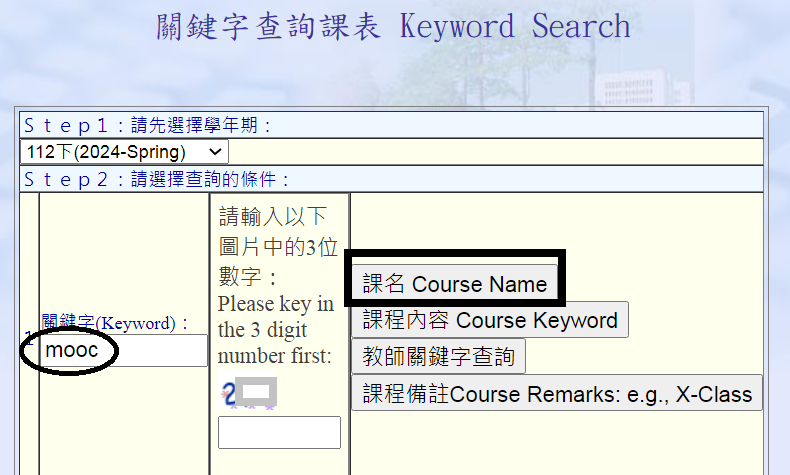Credit-based MOOCs
MOOCs (Massive Open Online Courses) Responsible Unit
Categories and Targets
- Credit-based MOOCs:NTHU and UST Alliance students and inter-collegiate students
- Non-credit MOOCs: High school students, university students, or general public
- Advanced Placement Courses: Senior high school students, NTHU freshmen
- NTHU FutureLearn (International MOOCs): University students, general public
About Credit-based MOOCs
Course Information
- You can find the Credit-based MOOCs within the school administrative system by using the course keyword search interface (as shown in the image below).

Course Registration
- NTHU students must enroll the course before the course-add/drop deadline each semester.
- Students from other schools must complete the inter-collegiate course registration process.
Learning Platform
- Courses must be taken on the specified platforms ("NTHU MOOCs" and "FutureLearn" platforms).
Frequently asked questions
What are "Credit-based MOOCs"?
Since 2023, NTHU has promoted "Credit-based MOOCs" as one of the digital self-learning solutions for students. Students are required to register for the Credit-based MOOCs in the school's course selection system and enroll on the designated platforms ("NTHU MOOCs" and "FutureLearn"). Students must fulfill the course requirement (e.g., interactions, assessment, quizzes, or assignments) on the syllabus (please refer to the syllabus and course announcements). If you pass the course, you will earn course credits. Please pay particular attention to the course start dates, as the start dates of Credit-based MOOCs may differ from traditional courses. Therefore, you will need to allow time for self-learning (Three steps: Select the course in the Course Information System → Register for the course → Study and follow the course schedule).
I have already taken some courses on the NTHU MOOCs platform before, can I get credits for them?
Previous courses you've taken on the MOOCs platform cannot be directly converted into credits. In addition to instructional videos, credit MOOCs include classroom interaction and evaluation, which are essential criteria for grade calculation. Therefore, only students who enroll and study in that particular semester can earn credits.
I'm not a NTHU student, Could I get credit for MOOCs??
Yes, you can enroll through inter-collegiate course selection. Students enrolled at University System of Taiwan, Chung Hua University, National Taiwan Sport University, and Taipei Medical University can take the course for free via inter-collegiate course selection. Apart from the above universities, students are required to follow the general inter-collegiate course selection mechanism (apply, pay, and enroll).
What are the benefits of taking Credit-based MOOCs for me?
Students taking online courses often lack self-discipline and may become distracted by other obligations or learning activities in their lives, failing to complete the online course. The Credit-based MOOC, which incorporates a credit mechanism, offers the support of teaching assistants and teachers for interactive discussions, and also arranges regular quizzes and assessments. This can help students develop good habits of disciplined and self-paced learning. Additionally, compared to traditional courses, the MOOC courses offer more flexibility and shorter study times, allowing students to manage their time more freely for other learning tasks.
What are the differences between Credit-based MOOCs and traditional courses?
Regular courses are primarily taught in 'physical classrooms' where students are required to engage in learning, assignments, quizzes and assessments for 16-18 consecutive weeks. The courses are often required theoretical or applied subjects within the department or program, and the workload tends to be heavier. Credit-based MOOCs mainly use pre-produced instructional videos, allowing students to learn at their own pace, whenever they want. These courses tend to be simpler (covering only essential concepts) and less demanding, providing an option for students interested in interdisciplinary learning or trying out specific courses without as much pressure
What is the difference between Credit-based MOOCs and regular MOOCs?
The overall design of the courses is similar. However, Credit-based MOOCs are tied to the school's course selection system, and according to the "National Tsing Hua University's Digital Course Implementation Regulations", they must incorporate relevant learning assessment mechanisms (interactions, evaluations, discussions), etc. Therefore, students taking these courses may be required to participate in additional assignments, exams, quizzes, etc. Regular MOOCs only allow students to apply for a free or paid certificate of completion (online transcript) and cannot be used for credits.
Why are Credit-based MOOCs less than three credits?
Since the MOOC videos are shorter and not designed for an 18-week course, Credit-based MOOCs are approved by the course offering unit according to the "National Tsing Hua University's Digital Course Implementation Regulations". Credits are counted in units of 0.5, and the course instructor and the affiliated unit co-determine the credits for the course.
If I take Credit-based MOOCs, will there be a score shown on my transcript?
Credit-based MOOCs follow a 'pass/fail' system, so there is no 'score' on the transcript, nor is it included in the calculation of the semester GPA.
